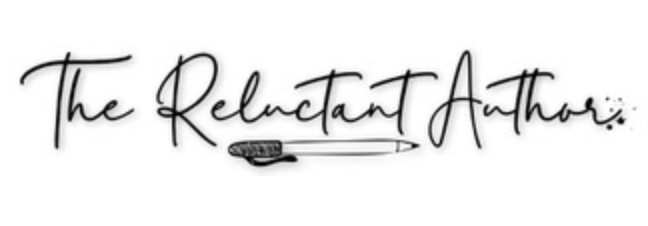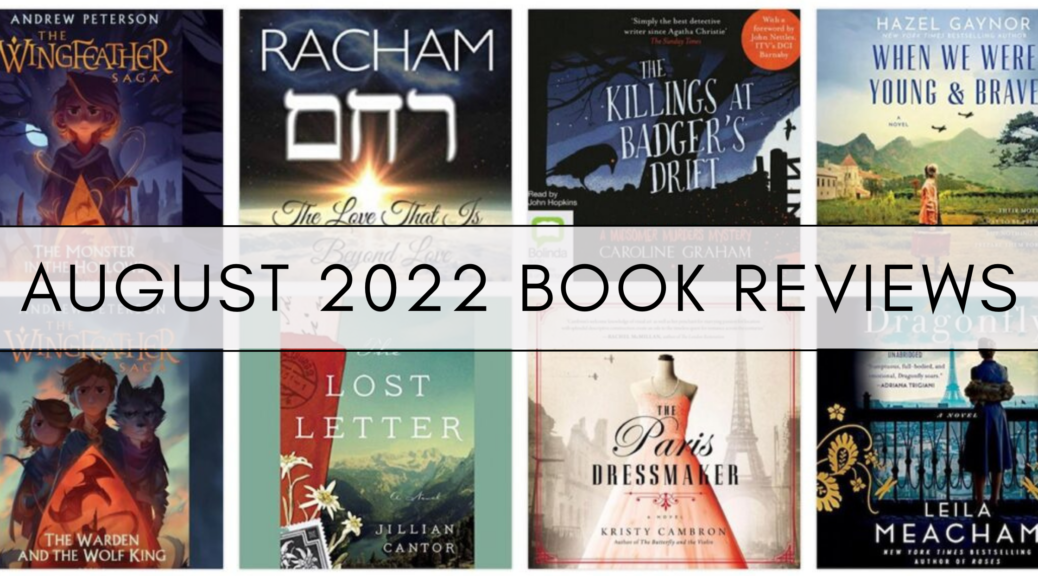
Book Reviews: August 2022
Yep, I’m still just a little behind, but I should be caught up soon. While I read 8 books in August, I only read 2 in September. It evens things out just a little bit. Although I really didn’t enjoy being stuck in the book rut. You have them too, right? Those moments when you read such a beautifully written book that no matter how hard you try, it’s just far too difficult to settle in with anything else? Or, in my case after finally picking myself up after the book hangover, I choose a book that I refused to give up on but didn’t really satisfy. Alas.
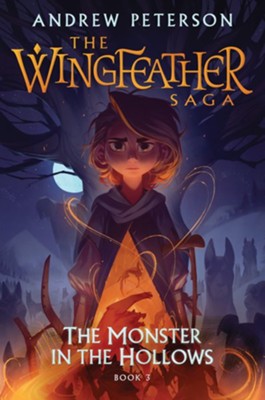
Title: Monsters In The Hollows
Simple Summary: The three Igiby children are hiding from Gnag the Nameless in the Green Hollows, but there’s a big problem. Tink has grown a tail and fangs, and to the people of the Green Hollows, he looks an awful lot like a monster.
Why I read it: It was rather hard to stop reading this series once I started, especially since Peterson masterfully leaves you hanging at the end of each book.
What I thought about it: As the Igibys are running for their lives we start to learn a little more about each character on a personal level. Tink doesn’t want to be king, and this leads him to make a very foolish choice. Yet, this choice is also what frees Pete both physically and mentally from his own bonds.
Unfortunately, the poor choice brings harm to the rest of the family. Janner’s capture and enslavement, & time wasted returning for Tink. Their mother’s heavy burden at abandoning her sons in order to save her daughter.
We finally learn why Podo is so afraid of the water, and how he lost his leg. It allows us to view him in a more human light as we examine his flaws, and see the character he was before he became the beloved grandfather. The redemption with the daughter of the Sea Dragon King is beautiful to witness too.
I found both Pete & Janner’s enslavement hard, and wished so much to set them both free. Yet, both bore it well and through their plights were able to find redemption, understanding, & ultimately freedom at the end.
What will happen next though? And if Tink was brought back from being a Fang, does this mean that the other Fangs can be saved as well? How will the knowledge that the Fangs were once children, neighbors, parents, and loved ones play out as the series progresses?
Would I read it again: Absolutely! When I finished this series in audio fashion, I took myself straight down to the local bookstore, and purchased the entire set in hardback. Or, at least the three they had on hand.
When it rages long enough, hate doesn’t need a reason. It burns for the sake of its own heat, and devours whatever or whomever is set before it.
Andrew Peterson
One word pulsing in him like a beating heart: Protect, protect, protect. And what had Janner done? Complain, complain, complain. … He didn’t want that to be his story. He didn’t want that to be the word that defined him.
Janner Wingfeather
“In the last few months he’d learned that impossible was a word that had little meeting.”
Janner Wingfeater
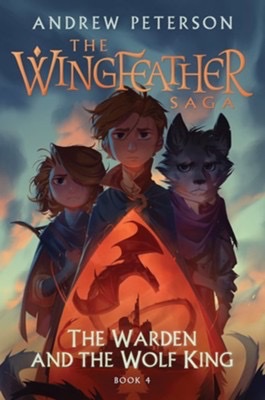
Title: The Warden And The Wolf King
Simple Summary: The peoples of the Green Hollows have prepared for the final battle with Gnag The Nameless and his Fangs of Dang. The Igiby children are ready and willing to right, but when the fangs make the first move invading Ban Rona, the children are separated.
Janner is lost in the hills, Leeli is fighting the Fangs in the city, and Kalmar is enroute for the Deeps Of Throg. Their only hope of victory lies in uniting and using their strengths together.
Why I read it: It’s the final book in the epic Wingfeather Saga!
What I thought of it: At long last, the final book in the Wingfeather Saga, and did not disappoint. Up steep hills, and down into low valleys was I carried on the final quest of this epic adventure. I found that, just like all the other books in the series, this was hard to put down. While there was hard content for a reader, watching characters we love, struggle internally and externally, I felt this was slightly lighter in many ways compared to North Or Be Eaten.
I appreciated that while this book is full of so many action scenes, we also get to dig into Janner’s inner thoughts and emotions a bit as he overcomes his frustration at constantly protecting a young brother who sees life as one great adventure. His redemption when Kalmar goes down to meet the maker was interesting. I’d felt, on a personal level, that Janner had already redeemed himself, but this was a deeper redeeming. This wasn’t just a moment of noting his thoughts and intentions were wrong, and shedding them. This was a deep moment for Janner to realize that even when he’d made peace with things, he’d done it out of obligation more than love. To see him not only act as the Throne Warden, but to have the internal change was beautiful to witness.
We also see Leeli as more than just the “little sister”. We see that her ability to play the whistle harp is so much more than just an activity she’s been tasked with. It becomes her ability to help the Green Hollow Clans fight for their lives, it becomes her way to connect with her brothers and remind them of her love for them.
I struggled with the death of Podo, despite the beauty and redemption in his choice. More than anything I wanted to slam the book shut at the end, face Mr Peterson and say, “I know, I know because the author in me is screaming, “Well played!”, but the reader in me wants an answer. I’ve reached the end and feel I could return again to Book 1.
Would I read it again: Oh yes, I think rereading the series would be much like revisiting old friends again and hearing them tell their story.

Title: The Lost Letter
Audible Summary: Austria, 1938. Kristoff is a young apprentice to a master Jewish stamp engraver. When his teacher disappears during Kristallnacht, Kristoff is forced to engrave stamps for the Germans and simultaneously works alongside Elena, his beloved teacher’s fiery daughter, and with the Austrian resistance to send underground messages and forge papers. As he falls for Elena amidst the brutal chaos of war, Kristoff must find a way to save her, and himself.
Los Angeles, 1989. Katie Nelson is going through a divorce, and while cleaning out her house and life in the aftermath, she comes across the stamp collection of her father, who recently went into a nursing home. When an appraiser, Benjamin, discovers an unusual World War II-era Austrian stamp placed on an old love letter as he goes through her dad’s collection, Katie and Benjamin are sent on a journey together that will uncover a story of passion and tragedy spanning decades and continents, behind the just fallen Berlin Wall.
Why I read it: This had been sitting in my “to read” pile for a while, and I’d intentionally put it off because it was a WWII book. Rereading the synopsis of the book, I decided to give it a chance. My hope was that it wouldn’t be deeply emotional, and I really didn’t find it to be that way.
What I thought of it: This book was historical fiction, romance, and mystery all woven into one story. The book opens with a scene that made me suspect it might be a hard read, but then quickly flashes forward to the late 1980’s. Here we meet Katie who is attempting to have her father’s stamp collection evaluated. She’s struggling with the fact that her dad has Alzheimers {a topic that I could completely understand..}, and is looking to see if he ever found the jewel he so desperately sought.
Things unravel from there, and slowly she learns that the jewel he sought wasn’t the “on in a million” stamp, because he created that. Rather it was someone he loved deeply and lost. The book follows Katie’s search for answers, while flipping back in time to see the characters she’s looking for as they go about the mystery she’s trying to solve.
I felt the outcome was somewhat predictable, although the author left me wondering for a while before confirming my predictions. I didn’t care for the first person narration when Katie’s story was being told, or maybe it was the way the female narrator read this book? I’m not sure, I can’t quite put my finger on it, but there was an aspect of it that made me cringe repeatedly.
I appreciated the raw beauty of how Tom, the father with Alzheimer’s, was represented. I appreciated the clean and tidy ending.
Would I read it again: I’m not sure.
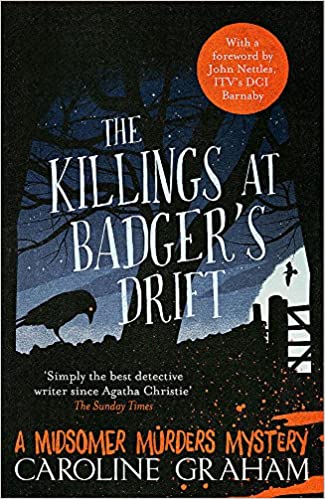
Title: The Killings At Badger’s Drift
Why I read it: This was an Audible Deal Of The day, and it was advertised as the inspiration behind the BBC series: A Midsommer’s Murder. I was sold immediately.
Audible Summary: The village of Badger’s Drift is the essence of tranquillity. But when resident and well-loved spinster Miss Simpson takes a stroll in the nearby woods, she stumbles across something she was never meant to see, and there’s only one way to keep her quiet.
Miss Simpson’s death is not suspicious, say the villagers. But Miss Lucy Bellringer refuses to rest: her friend has been murdered. She is sure of it. She calls on Detective Chief Inspector Barnaby to investigate, and it isn’t long until the previously unseen seamy side of Badger’s Drift is brought to light. But as old rivalries, past loves and new scandals surface, the next murder is not far away.
What I thought of it: I stumbled upon this book when I saw it advertised as the book that inspired the hit tv series: Midsomer Murders. I had not realized that the show was originally based on a series of books, and thus I was excited to read them. Even more enjoyable than this knowledge was obtaining an audio copy and hearing John Nettles’ letter to readers. I was fascinated that the actor felt the books were better because of the limitations of “the box”, and the demands of an audience for more action.
He wasn’t wrong either. The books have so much more substance and depth than the show, and I found it difficult to put down. It was charmingly read by John Hopkins who sounded so much like John Nettles version of Inspector Barnaby that for a time I thought that’s who was reading to me!
I found it interesting that in the books Troy is loathsome, and not all the bumbling, well meaning, up and coming, Sargent in the police force. No, he is down right, detestable at times. Joan’s inability to cook is made much clearer in the books, and I laughed so hard when she quit cooking school. Cully, while loved by her parents, doesn’t have the warm affectionate relationship as shown in the tv series. She’s a young adult and with that comes the normal family dilemmas.
I think my favorite thing about the story was that the “who done it” was not so obvious. Despite the fact that I’d watched the show previously with my mother-in-law in her pre-dementia days. The mystery was masterfully woven and not so simple to solve. I delighted in that. Compared to other cozy mysteries where you know the answer pretty quickly and read on to see how the culprit is caught, this felt the opposite. You watch the lives of a village, and wait to see who cracks to discover the guilty party.
Would I read it again: I would, I’d even love to hunt down the entire series to put in my physical library collection.

Title: When Were Young And Brave
Why I read it: I’m not entirely sure what drew me to this book other than its name which was oh so similar to a picture book I read to my children many years ago. Upon reading the book’s description it sounded interesting, and the rest, they say, ‘is history.’
Amazon Summary: China, December 1941. Having left an unhappy life in England for a teaching post at a missionary school in northern China, Elspeth Kent is now anxious to return home to help the war effort. But as she prepares to leave China, a terrible twist of fate determines a different path for Elspeth, and those in her charge.
Ten-year-old Nancy Plummer has always felt safe at Chefoo School, protected by her British status. But when Japan declares war on Britain and America, Japanese forces take control of the school and the security and comforts Nancy and her friends are used to are replaced by privation, uncertainty and fear. Now the enemy, and separated from their parents, the children look to their teachers – to Miss Kent and her new Girl Guide patrol especially – to provide a sense of unity and safety.
Faced with the relentless challenges of oppression, the school community must rely on their courage, faith and friendships as they pray for liberation – but worse is to come when they are sent to a distant internment camp where even greater uncertainty and danger await….
Inspired by true events, When We Were Young and Brave is an unforgettable novel about impossible choices and unimaginable hardship, and the life-changing bonds formed between a young girl and her teacher in a remote corner of a terrible war.
What I thought Of It: I loved that this book told about an aspect of WWII that many people aren’t familiar with: Internment Camps for ally countrymen who were living abroad at the time of Japanese occupation of China. The book focuses primarily around a small group of Guide Girls who are led by Miss Kent. The story is told from the viewpoint of Miss Kent and Nancy, with only an occasional interruption from another character in the book.
The story itself is, I suppose, not entirely unheard of in the sense that one young woman is left to care for and protect a group of young people. Yet there was something gut wrenchingly familiar and unfamiliar about Miss Kent’s view points. There was the deep understanding of being thrown into the roll of caregiver without asking for it, the fear that you are messing everything up, and the need to plant a smile on your face when all you really want to do is curl up in a ball and wake up when everything is normal again.
When Miss Kent saw herself as weak and incapable, the girls in her charge saw her as solid and dependable. What, for Miss Kent, was a nightmare and grueling experience, became a lifetime of memories for the young girls left in her charge.
For Nancy, Miss Kent is not just a teacher, but a mother. She longs for her own mother to call her, to visit, to write. To come and collect her from the nightmare she feels trapped in. But it’s Miss Kent who fills all those needs, who is there for her in the darkest of days, and the happiest of events. It is Miss Kent who becomes her inspiration as an adult to repay all the kindness and beauty Miss Kent shed upon her life.
Would I read it again: Yes, a million times over.
Our war became one of small daily battles as we shared out the precious egg shells and looked wearily at the charts we’d drawn up to record the girl’s victories and various challenges and competitions we’d fabricated from the most awful tasks
Miss Kent (Ch 31)
“Books aren’t museum pieces to be admired from a distance, they are meant to be lived in, messed up a little.”
Ch 32
What if after all this time apart we couldn’t remember what we were supposed to do when together.” –
Nancy (Ch 22)
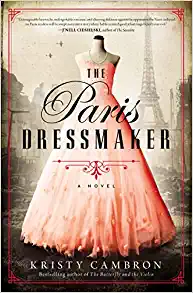
Title: The Paris Dressmaker
Why I read it: Yet another WWII book I found in my stash and decided to read it rather than let it collect dust. I’m not sure when I acquired so many, or even why…
Amazon Summary: Based on true accounts of how Parisiennes resisted the Nazi occupation in World War II – from fashion houses to the city streets – comes a story of two courageous women who risked everything to fight an evil they couldn’t abide.
Paris, 1939. Maison Chanel has closed, thrusting haute couture dressmaker Lila de Laurent out of the world of high fashion as Nazi soldiers invade the streets and the City of Lights slips into darkness. Lila’s life is now a series of rations, brutal restrictions, and carefully controlled propaganda while Paris is cut off from the rest of the world. Yet in hidden corners of the city, the faithful pledge to resist. Lila is drawn to La Resistance and is soon using her skills as a dressmaker to infiltrate the Nazi elite. She takes their measurements and designs masterpieces, all while collecting secrets in the glamorous Hôtel Ritz – the heart of the Nazis’ Parisian headquarters. But when dashing René Touliard suddenly reenters her world, Lila finds her heart tangled between determination to help save his Jewish family and bolstering the fight for liberation.
Paris, 1943. Sandrine Paquet’s job is to catalog the priceless works of art bound for the Führer’s Berlin, masterpieces stolen from prominent Jewish families. But behind closed doors, she secretly forages for information from the underground resistance. Beneath her compliant façade lies a woman bent on uncovering the fate of her missing husband … but at what cost? As Hitler’s regime crumbles, Sandrine is drawn in deeper when she uncrates an exquisite blush Chanel gown concealing a cryptic message that may reveal the fate of a dressmaker who vanished from within the fashion elite.
Told across the span of the Nazi occupation, The Paris Dressmaker highlights the brave women who used everything in their power to resist darkness and restore light to their world.
What I thought: I was leery going into another WWII book, after all it’s a time in history that can be quite difficult to read about. Having said that, this book focused more on the fashion and arts of German occupied France. We followed the lives of two women. Lila, who enters the fashion industry and works as a spy to learn all she can from the German military’s wivess and mistresses while she helps clothe them for grand events.
There is also Sandrine, who’s husband is off fighting for France. She works in cataloging artwork for the Nazi’s and secretly works to keep records so that Jewish artwork is not burnt, lost, or destroyed. All accomplished, while under the watchful eye of a Nazi solider who has fallen in love with her.
There is a lot of content that was lost on me when it came to the fashion side of the book, but I still found it interesting how people found a way to remain employed while still serving their country. Each woman faced hardships and battles of their own both public and personal. Sandrine, for instance, was spat upon, mocked, and called rather grotesque names in front of her child while attempting to purchase a loaf of bread. All because the local women believed she loved the Nazi solider in return. Even her mother-in-law, who lived with her, was convinced of this.
I found it interesting that the author touched on true facts sprinkled amongst her story. One that has stuck with me is that the Parisian women took it upon themselves to dole out punishment when their city was finally freed. Women who were known to consort with the enemy were punished and shamed, from being beaten to having their heads shaved. Those whose lives were not taken walked around with barren heads for all the city to know that they’d been traitors.
Would I read it again: I think I would. I think it touched on parts of life for the French peoples that many of us don’t think about. While the fashion aspect really was not my thing, I was intrigued by the great efforts the characters went through to save art: including expensive dresses that belonged to Jewish families.
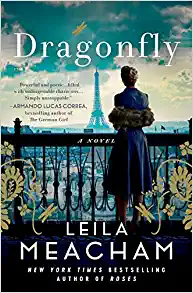
Title: Dragonfly
Why I read it: I found it in my personal library collection, no memory of having acquired it, and the summary sounded intriguing.
Amazon Summary: At the height of WWII, five idealistic young Americans receive a mysterious letter from the OSS, asking them if they are willing to fight for their country. The men and women from very different backgrounds – a Texan athlete with German roots, an upper-crust son of a French mother and a wealthy businessman, a dirt-poor Midwestern fly fisherman, an orphaned fashion designer, and a ravishingly beautiful female fencer – all answer the call of duty, but each for a secret reason of his or her own. They bond immediately, in a group code-named Dragonfly.
Soon after their training, they are dropped behind enemy lines and take up their false identities, isolated from one another except for a secret drop-box, but in close contact with the powerful Nazi elite who have Paris under siege.
Thus begins a dramatic and riveting cat-and-mouse game, as the young Americans seek to stay under the radar until a fatal misstep leads to the capture and the firing-squad execution of one of their team. But…is everything as it seems, or is this one more elaborate act of spycraft?
What I thought: It took very little time to be fully engrossed in this story. Each character’s background left them longing for more in life, making them ripe for the picking by the OSS. I felt like I no sooner caught my breath with one incident than another began. Yet again, touching on the occupation of France when Germany invaded.
The story gave glimpses into how both the Persians and the Germans fought back against Hitler in subtle ways. We also see how the German-Americans were affected, losing jobs, being discounted, and unwanted by both the German army and the American peoples. The aftermath of those who enlisted as spies and barely escaped with their lives, was also touched upon. How the men and women didn’t ignore what had happened in their lives, they simply chose not to speak about it.
I was pretty convinced there was going to be a very difficult part in the book based on the opening, and while there was, I’d urge you not to lose hope. Keep reading, and relish the ending.
My only negative with this book lies with me. For some bizarre reason I thought this book was based on actual real events that took place. So I went off scouring the internet looking for a mural that plays a huge role in this story. Coming up empty handed again and again, I finally read the back of the book again only to realize that my mind had somehow presumed the “true story” aspect.
Would I read it again: Yes, and I’d likely plow through it just as quickly again. I’d probably even go hunting for that mural again.

Whew, August was a whirlwind of reading, wasn’t it? I suppose it makes up for September, in which I read very little. Somewhere between the end of the Aussie Rules season, the hope of autumn, a vast amount of medical appointments, and a slightly dud book I derailed a bit. But, I’ll have to share all about that in another post.
Are you playing along to see which book you read will be your 2022 Book Of The Year? I am, here’s a glimpse at where all my titles stand. I confess that sometimes it’s downright hard to pick which title I felt was the best. Even books that didn’t enrapture me as much as I would have liked have something about them that sticks with me, and I sit there having a silent debate with myself over which book will be the winner.
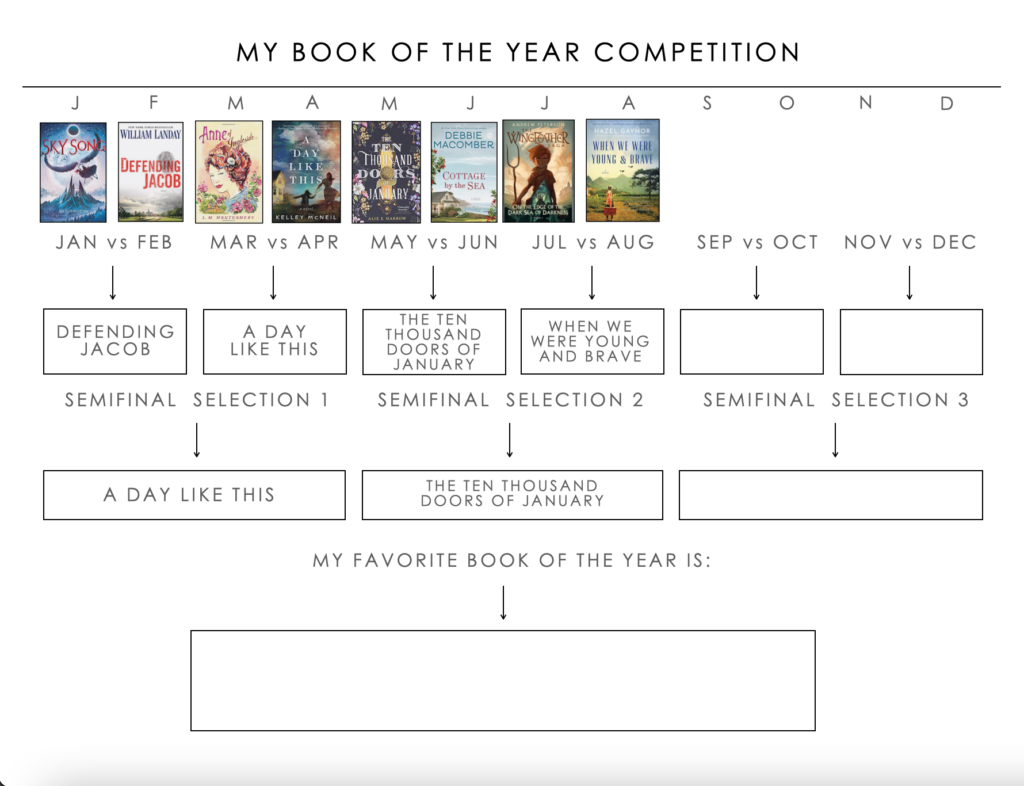
This month was pretty hard, because finishing off Wingfeather made it quite difficult. It was a big toss-up between Book 4 in that series and When We Were Brave And Young. In the end I chose the latter mostly because I’d already selected a WingFeather book the month before, but also because I can still hear Miss Kent’s story roaming around my head.
If you haven’t grabbed the Book Of The Year free download, you can do there here.
